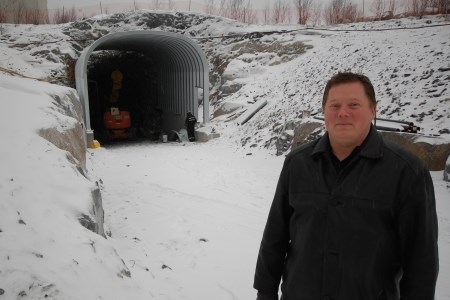Sudbury’s Mining Technologies International Inc. can now test and showcase its newly designed mine equipment in its own underground environment.
As one of the Canada’s largest manufacturers and suppliers of mining equipment, MTI has constructed its own test tunnel on the west side of its Magill Street property. A natural rock outcrop provided the perfect spot to build a decline that will be extended as far as 300 feet underground to test its products in an actual working environment.
“We wanted to be able to demonstrate with our small narrow vein jumbo that we can effectively produce the same size drift our competitors do with larger, more expensive equipment,” said MTI’s president and CEO Bob Lipic.
The project began in the fall of 2009. By December 2010, the decline extended 200 feet at a 15-per-cent grade. It is a 5.2-by-5.2-metre tunnel, the standard dimension of most Sudbury mines. Other features found in a mine will also be part of this simulated site, like ventilation, a roadway to the entrance and eventually doors and heat at the portal to keep the entrance from icing.
The ability to test and tweak the product prior to shipping means MTI’s clients will receive a turnkey product that is “ready to go” upon arrival.
“We don’t have a very effective way to test equipment before we ship it to a mine,” said Lipic. “If we are able to do it at home and set the hydraulic system so that it closely resembles what it will do on a day-to-day basis, it is better to do it here.”
Building the test tunnel also provided an opportunity to showcase two newer products that are now being marketed: a Micro CPA drill and the RJ21 Hydra-crusher, both of which are interchangeable with other equipment.
The Micro CPA is a lightweight drill smaller than the larger CPA 1100, and is designed to attach onto excavators from four to 10 tons. It has one-tenth of the mass and is capable of drilling up to a 1.5-inch diameter hole.
“We drilled off the entire entrance to the portal (of the test tunnel),” Lipic said, adding that the Micro CPA sparked interest from others during that time, which resulted in several jobs.
It can drill up to 10-foot holes and is well-suited for surface applications like small construction sites, sidewalk work, around houses and small outcrops. But it has mining applications too. Lipic explained that the drill was used to start sinking a ventilation shaft down to about 300 to 400 metres for Agnico- Eagle in northern Quebec
“It is very versatile and a low-cost alternative to a full-percussion drill,” said Ryan Lipic, MTI’s marketing manager, adding that the drill comes with a dust collector and remote control.
The other product is a portable rotary-jaw crusher. Its new design from a cylinder-based crusher to a rotary-jaw crusher has made it more powerful, efficient and faster.
The RJ21 crusher, used for above-ground applications, has processed as much as 105 tons per hour. It can take rock between 12 and 14 inches in size, and reduce it to between six inches and three-quarter inch size.
It was initially tested at the old Moose Mountain Mine north of Capreol, which has some of the hardest rock around. “If it crushes there, it will crush anywhere,” Bob said.
Outside the shop, various piles of different-sized crushed rocks from the test tunnel are a testimony to how efficiently the crusher works.
Presently, MTI is developing a similar design for its underground crushers in order to resize waste rock for roadbed construction in the mines.




